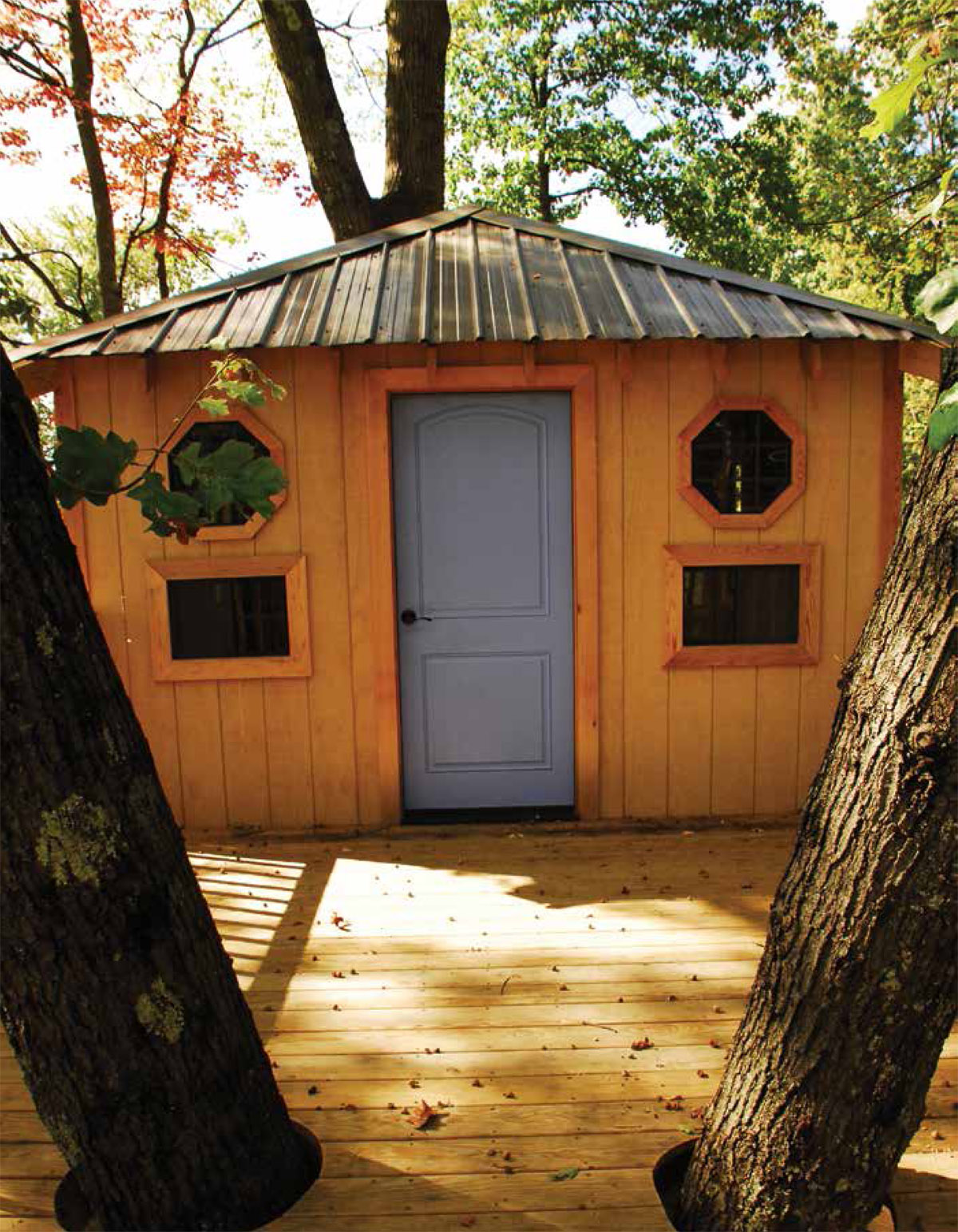

 CHAPTER 3
CHAPTER 3
Two basic questions will help you determine which trees are suitable to build in:
1.Is the tree healthy?
2.Is the tree strong?
Many trees are one but not the other. The healthiness of a tree is an assessment of its level of biological function. The strength of a tree is an assessment of the structural quality of its wood. A stump, or topped tree, is biologically dead, but the wood may remain structurally sound for a very long time, depending on the species and environment. Alternatively, a tree might be hollow and decaying on the inside but have leaves on every branch and be very much alive biologically on the outside. Seeing the tree independently through these two lenses will give you a complete picture of the overall suitability of any tree, regardless of species. All suitable trees for building treehouses will be healthy and free of major structural defects. In this section I explain what to look for during initial tree assessment and when to call for an expert arborist’s help.
The essential biological function of a tree is to use nutrients to create starch, which fuels structural growth, reproduction, and wound response mechanisms. Starches are also stored for later use and used by beneficial fungi that exist symbiotically underground. The level of starch production and use is the simplest way to describe the overall health and biological function of any tree. When trees are thriving biologically, they can grow to over 300 feet tall, over 20 feet thick, and live over 1,000 years. Granted, not all tree species have these capabilities, but each specimen has the potential to thrive as a prime example of what its species can become.
The environment where the tree is growing is primarily responsible for its biological success. Unfortunately for trees, they cannot walk around and find a better environment. They do their best with where they grow. Let’s consider some environmental factors that help trees grow well.
PICKING THE PERFECT TREE
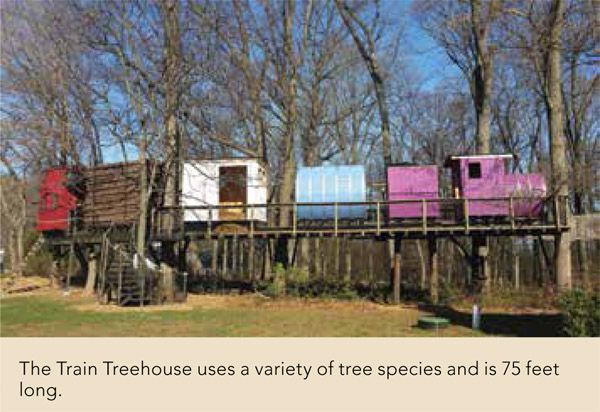
There is no best tree species to build a treehouse in. Yes, some are better than others, but most trees are OK to use when they are good specimens and in a suitable environment. The Train Treehouse at Treehouse World uses two red oaks (Quercus rubra), two pignut hickories (Carya glabra), a Norway maple (Acer platanoides), and a cherry (Prunus avium). The cherry TABs had the lowest strength-test values, but all of the trees show excellent wound-wood formation. The train cars are all built like two-tree treehouses, and they are all unique in design. You can walk through each car, blow the real steam whistle, and take your picture in the engineer’s window.
There is no “one soil fits all” approach to trees. Some trees can tolerate different pH levels, soil structures, water saturation levels, or soil compositions. However, most of the research about soil has to do with planting new trees. The purpose of the studies is to identify which trees will thrive when planted in certain environments and for certain purposes.
For treehouses, we have a different question: Which trees are thriving in their current environment? We are considering established mature trees that have proven at least a minimum level of soil suitability. However, you should be looking for signs that the tree may not be firing on all cylinders, and if you see the signs, then it is most likely due to soil compaction or nutrient deficiency. People usually assume that if the tree looks unhealthy, then it has a pest killing it. Common pests include the emerald ash borer, hemlock woolly adelgid, pine bark beetle, and some others. However, you can locate the cause of most tree suffering by looking at the soil environment.
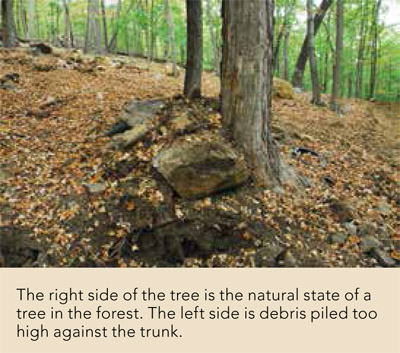
Poor soil environment will result in poor tree growth. Remember that trees need to move nutrients from the soil up to their leaves in order to grow. You may find that your tree has yellowish leaves in full summer. Compare the fullness of your tree’s leaf canopy to other trees of the same species. Look at the average leaf size or growth of shoots at the tips of a couple branches and compare these to other trees of similar age and species. Are all of the branches alive? A few dead branches on the inside of the tree canopy is usually normal as large trees mature, but if the outside of the canopy has a lot of small dead twigs at the outer branch tips, sometimes called perimeter “dieback” by arborists, then the recent growth of the tree is not going well.
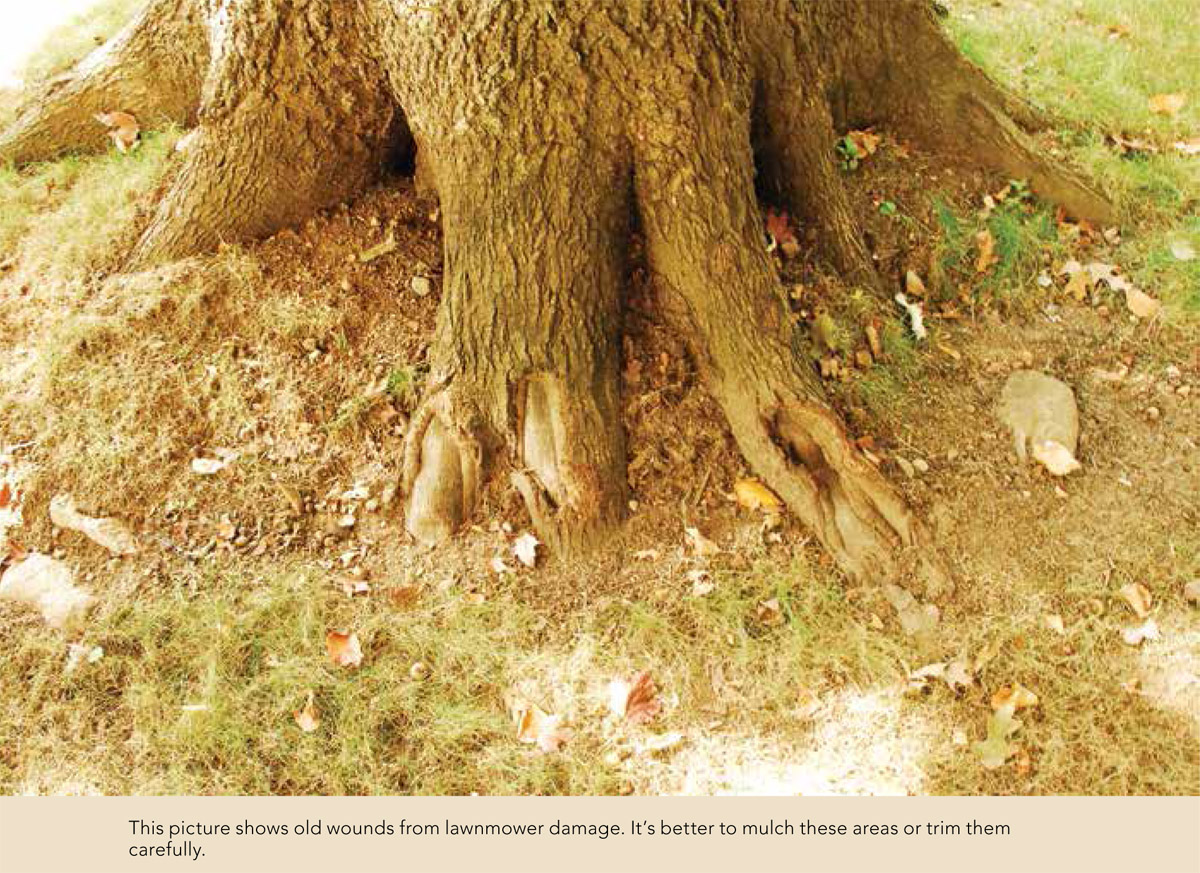
When trees are suffering like this, it is most often due to root damage or soil compaction. Severing roots and compacting soil will decrease nutrient uptake, which can result in the low-vitality signs described earlier. Typically, root damage is due to changing the grade by adding or removing soil near the tree or by excavating for trenches, sidewalks, and swimming pools. However, it can also be due to mower or vehicle contact. Soil compaction is usually due to walking and driving on the soil. The compression reorganizes soil particles closer together, which removes air spaces. The lack of pores in the soil makes the soil drain slower, reduces gas exchange, and reduces the intake of nutrients from the soil. Try to avoid walking and driving on soil in general, but especially when the soil is wet, because soil structure becomes compacted more easily when particles are suspended in water.
Nutrient deficiencies can also restrict tree vitality, but it is often difficult to assess what’s going on without taking soil samples and getting them tested in a lab. State university systems are often a good resource if you wish to test the soil. I do not recommend adding nutrients to soil or attempting to alter pH levels without first testing the soil. Fertilizing a tree before soil testing could not only be a waste of money and time but could actually make it worse.
Trees need soil with the right organic nutrients—specifically the “macronutrients” of nitrogen, phosphorus, potassium, magnesium, calcium, and sulfur. There are many other “micronutrients” that trees need in smaller amounts, such as iron, copper, chlorine, zinc, manganese, boron, and molybdenum.
A WORD ABOUT YARD LEAVES
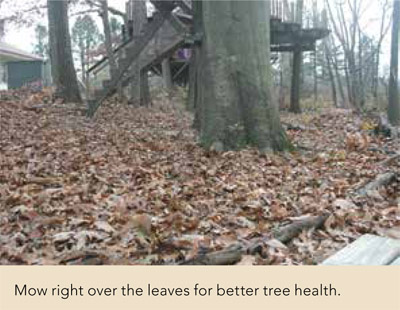
The soil in places where all of the leaves are dutifully picked up every fall for decades can be nutrient deficient. In nature, fungi break leaves down and add the nutrients back into the soil. When leaves are removed, the soil changes. Fertilizer can help, although many fertilizers are deficient in many of the micronutrients that leaves and twigs contain. A good practice for long-term soil management is to mow or mulch the leaves and “leaf” them where they lie, as long as you don’t mind looking at them for a couple of months while they break down and enrich your soil.
It can be hard to get started as a little guy in this world. Every spring, we see the forest floor raise up little first- and second-year saplings, but very few of them reach maturity. In order to survive, a tree must collect nutrients from the ground, catch sunlight from the sky, deal with various conditions and variables, and hope for a healthy dose of luck. If a dozen trees grow close together, the ones that grow just a little taller will have a competitive edge in the sunlight contest. That will spur root growth, which will help them have an underground advantage as well.
Trees that compete for light will grow taller and have less taper. Trees that grow in the open by themselves will develop larger branches attached lower on the trunk. The lower branches and increased taper will help the tree resist the higher wind forces out in the open. As a result, if a tree grows up in a forest, but nearby trees are cleared to make yard space, the tree can suddenly find itself with a narrowly tapered trunk and exposed to new wind forces, placing it at higher risk of wind damage.
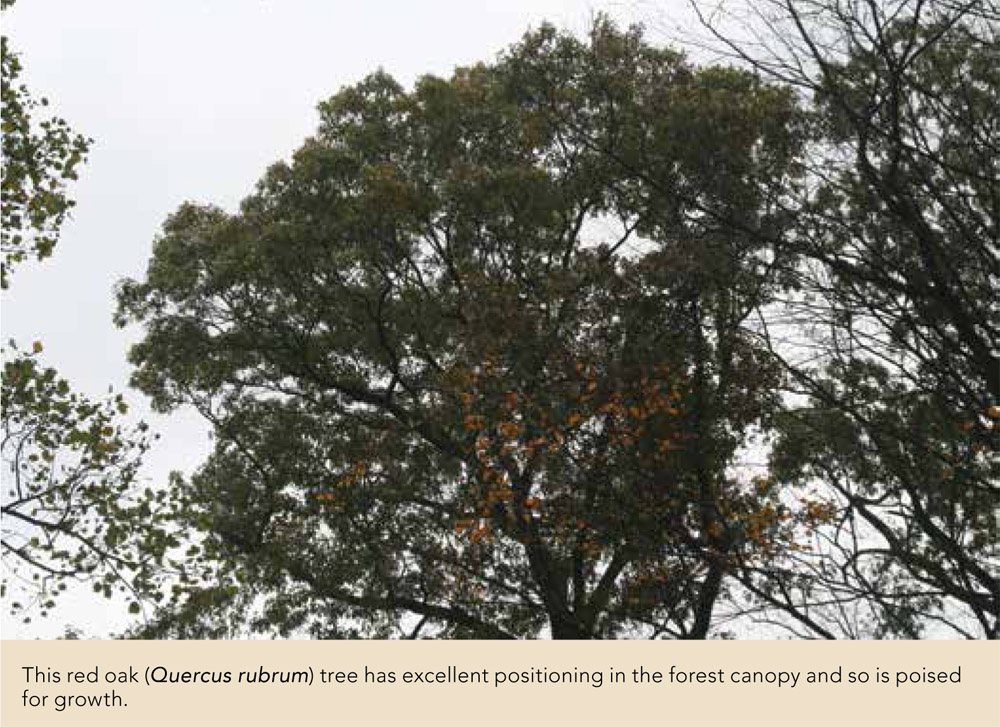

When evaluating trees for positioning, look first at the shape of the crown as it relates to the forest canopy. Does the top of the tree get direct sunlight? Do branches on all sides of the tree get direct sunlight? Next, evaluate the spacing of the trunk to other trees in the area, which will give you an indication of how much the roots interfere with those of other trees. The closer together trees are, the more likely they are to compete in the structural root zone, have branches that rub against each other, and share the sunlight. The ideal tree to build a treehouse in will have average or better competitive positioning for sunlight and soil root space compared to all adjacent trees.
It is beyond the scope of this book to list the various beetles, aphids, scales, and bagworms that can hurt or kill trees. The emphasis here will be on recognizing any visible evidence that the tree is under attack and getting an expert arborist to assist in diagnosis when prudent. Many of the signs are the same as for root stress: discoloration, slow growth of shoots, small leaf size, and so on. However, some attackers also cause defoliation, leave exit holes in the bark, leave trails or nests visible on the trunk or leaves, or just reveal themselves by crawling around. If you see something unusual, you can research it or call in a professional to make sure that you do everything possible to pick a healthy tree and keep it healthy.
Which came first, the trunk or the leaves? Well, the smallest of saplings are just small green shoots with a handful of regular-size leaves. Then in year two, they get a little taller, and the first year’s growth starts to resemble wood. The seed contains some stored energy that fuels the original sprout. If conditions are good and those first few leaves collect some sunrays, then more starch is produced to fuel growth for a stronger structure and new leaves. If a deer notices the tender green shoots in the first couple years and nibbles them off, then the tree may run out of energy and die. Each year the biological function creates better structure, and that new structure supports new leaves higher in the air, which increase the next year’s starch production.
Woody plants have a distinct advantage over nonwoody plants in the long run. Nonwoody material may grow faster initially, but the woody structure helps plants to support their chloroplasts higher in the air above nonwoody plants, and thus outcompete grasses and the like in the long run, not to mention they get out of the reach of deer, eventually. Trees even compete with each other, with some fast-growing species initially reaching canopy dominance, only to be overtaken by slower-growth trees that have better structure or evergreens that can keep photosynthesizing all year.
Most treehouse trees have a centralized, or excurrent, structure. A central leader is the tallest and most dominant stem of the tree, and branches radiate outward on all sides. When inspecting the branch-to-trunk attachments, you want to see relatively small branches clearly enveloped by the vertical trunk. A rule of thumb is that branches are generally not more than about a third of the diameter of the trunk where the two join. Larger branches are likely competing with the leader for dominance. The most common structural problem with competing large branches is that the tree can develop included bark between the branch bark ridge and the trunk, which becomes a structural weak point. Such conditions are often called codominant stems. These are unreliable junctions in the tree, which lead to big splits or tear-outs during high-stress events like windstorms. Sometimes a weaker codominant stem can be reduced, which can improve tree structure over time.

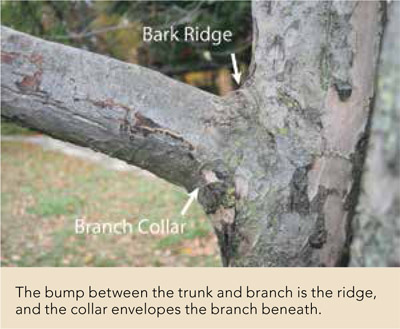
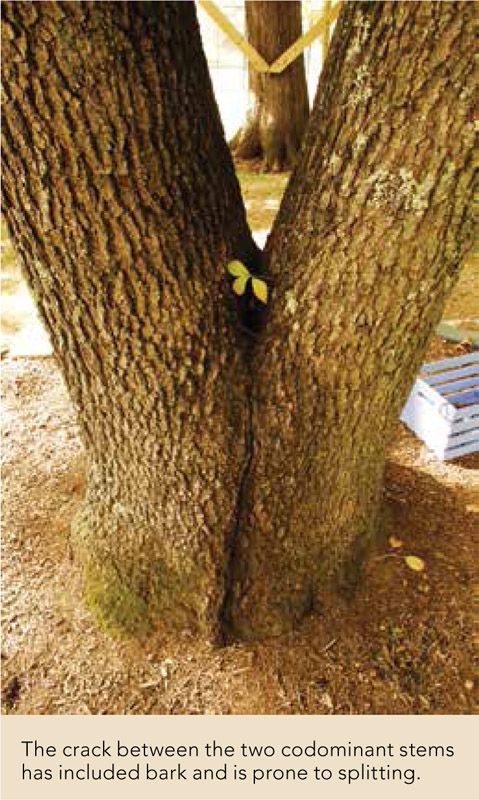
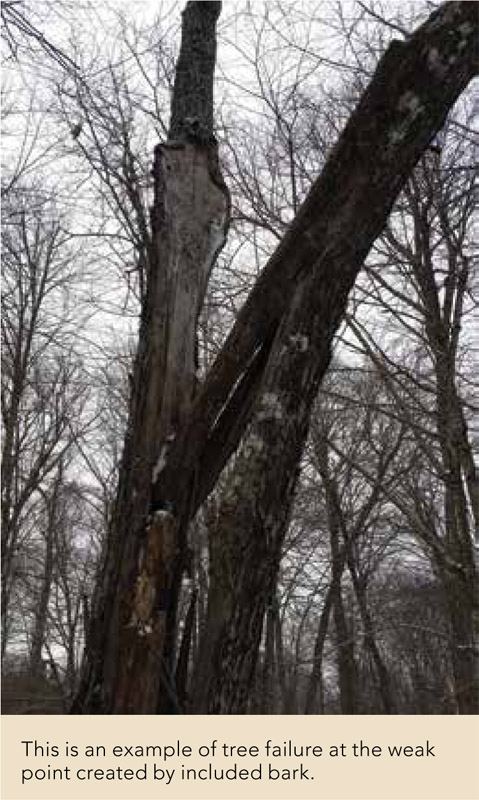
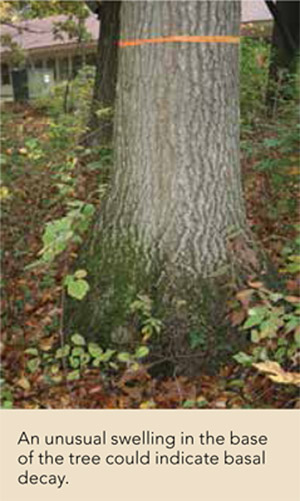
Some hollow trees are still OK to use for treehouses, but consideration should be given to the extent of the dead tissue. Arborists generally recommend removal or reduction for trees that are over one-third hollow in the center. If the cavity is small and contained, then it will be less of an issue for the tree in the long run. However, conditions like butt rot, where the center of the tree is rotting from the ground upward, are likely to keep getting worse over time. This condition affects several of my scarlet oak and northern red oak trees at Treehouse World, and I have made the decision to leave them and enjoy them a few more years, but not to invest in building treehouses in them, as they will eventually have to be removed.
Sometimes, while installing a TAB, you may encounter soft wood or discolored wood. It is important to note the depth and quality of the tree in order to assess whether the attachment point is still reliable to use. As we will discuss in future chapters, it is the wood on the outermost layers of the tree that is carrying most of the load of the treehouse, so if the back of the hole hits a contained hollow spot where a branch used to be, then this is not usually a significant concern. The age of the tree matters a lot. Younger and middle-aged trees will generally recover from early wounds. Mature trees have slower growth rates and are more susceptible to spreading wood decay.
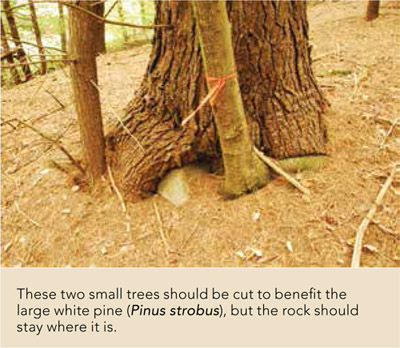
Absorbing roots of large trees may extend 100 to 200 feet away from the trunk, but most of the structural roots that are anchoring the tree are within the top 3 feet of soil and within about 6 to 15 feet from the trunk. These are the roots that keep a tree from blowing over. Look at the roots where they start to turn horizontal and dive underground. Make sure that there are no girdling roots or major root flares that are dead or severely damaged. This is often caused when construction equipment bumps trees or digs trenches tangential to the tree trunk.

A tree should generally not have material packed up against the trunk. This happens a lot with new plantings that get volcano mulched or buried too deeply. Root crown clearing is a good idea in these cases. However, in the woods, a root crown clearing is usually unnecessary, as trees tend to grow at the proper height. If you do find excess material such as logs or big rocks touching the trunk, then you should pull them away as long as you don’t cause further damage to the tree. For example, if the tree trunk is already growing around a rock, then removing the rock might open a wound in the tree. In this case it would be better to leave the rock. With trees like coastal redwoods that naturally drop leaf piles around their trunks and the material naturally builds up, there is no need to dig it all away unless there is another good reason for a root inspection.
Being a treehouse builder, arborist, and all-around expert on things built in trees (or “tree geek” for short), I pay a lot of attention to the way trees respond over time to various types of structural damage. I have seen trees wounded from natural causes, like storms and animal rubs, and wounds from people, like lawnmower strikes, carved initials, deer stands, nails and hooks, pruning cuts, and, of course, TABs and other treehouse-building methods. Understanding wound response in trees could be the single most important bit of theoretical knowledge you take away from reading this book, as it will affect how you work in and around your trees.
Trees Don’t Heal, They Seal!
When something cuts human skin, the body grows new cells to replace the damaged cells. Old, damaged cells are removed by the circulatory system. Trees, however, do not remove or replace damaged cells, but rather they seal them off chemically and add additional structural tissue around the wounds that compensates for the initial lack of strength. As a result, any wound on a tree will remain for the lifespan of the tree. Typically, the new compensatory growth (often called callus tissue) closes around a wound from the left and right sides of a wound before it does around the top and bottom. The reason this occurs in this pattern is that the tree’s circulatory system comprises elongated cells that connect vertically end to end, forming strings of cells. The sides of the wound are closer to unbroken strings of cells, which allow for a faster supply of starches and therefore faster growth of callus tissue.
CODIT
Dr. Alex Shigo had a unique approach to studying trees. He cut them up and studied them from the inside out. He developed a model for compartmentalization of decay in trees, or CODIT. The trees tend to seal off wounds in patterns. His four walls of compartmentalization are 1) vertical spread, 2) circumferential spread, 3) inward spread, and 4) outward spread. Wall 1 is the first to fail, the last to seal with callus tissue, and the most important for bearing most loads associated with treehouse building.
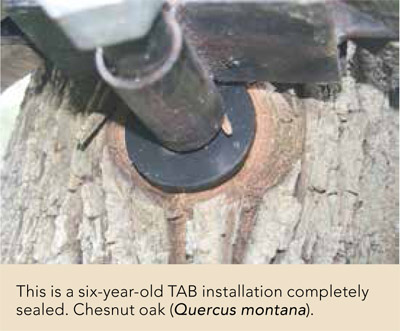
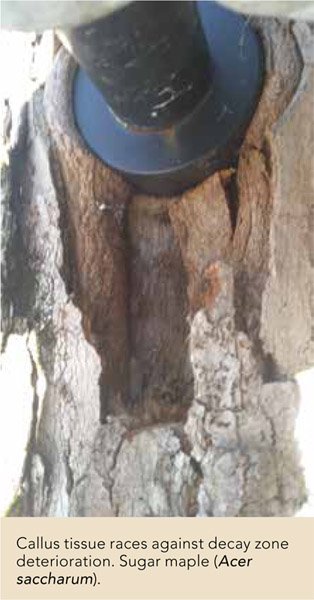
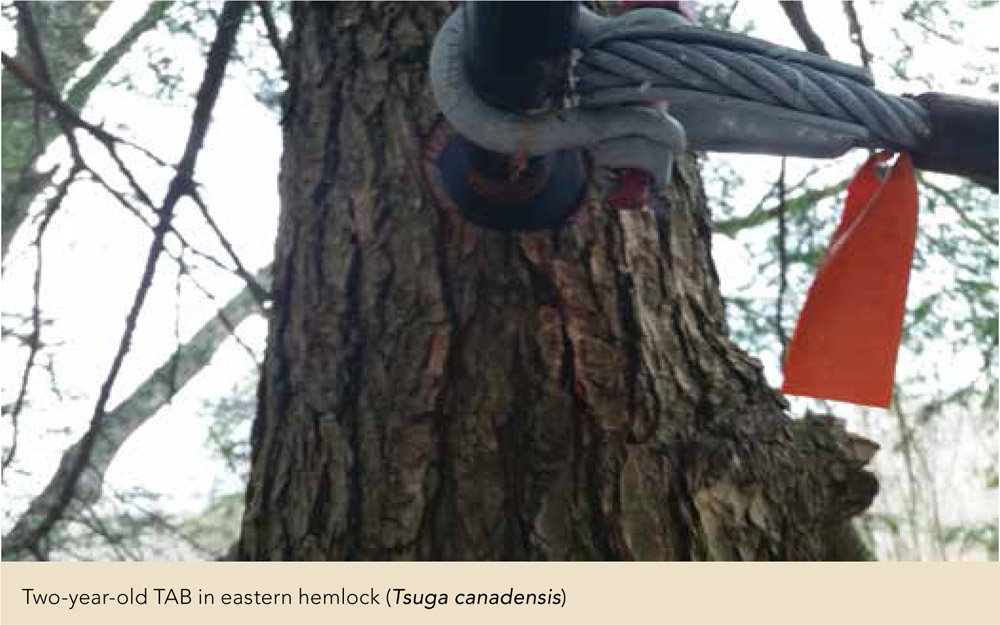
Wounded tree tissue in an otherwise healthy tree is immediately sealed off from the rest of the organism. The area that gets sealed off immediately starts to decay, so we can call it the decay zone. Wood decay rates vary greatly. Some trees will rot and become nonstructural in a matter of a couple years, while others will last multiple decades before becoming nonstructural. I use the term “nonstructural” to indicate that the wood becomes so soft that if a TAB is bearing on it, the load from the treehouse will eventually push the TAB downward through the decayed wood. As the decay zone deteriorates, the tree adds new growth rings each year and adds callus tissue around the wounded area, which bolsters the TAB and holds it secure in new healthy tissues. The “race” is whether the tree can add sufficient tissue after the installation before the decay zone becomes nonstructural. Of course, I cannot offer blanket statements about timing and predictions. Tree species, age, shape, and overall vitality are the most important factors that affect decay rates and rates of callus tissue formation.
Trees are generally best left alone by humans. However, when we decide to prune tree branches, there are definitely right and wrong ways to do it.
How Much Is OK to Prune?
Every leaf-carrying branch removed will reduce the total photosynthesis of the tree in subsequent years. You don’t want to reduce this at all, because you want the tree to have a strong reaction growth response to the bolts that will hold up your treehouse. However, a small amount of pruning may be required for the project. Arborists try not to prune more than 10 percent of the leaf crown of a very mature tree, because the older the tree gets, the more it has to use all available energy just to maintain its structure. Younger trees are using a higher percentage for growth, so it might be OK in some situations to prune 20 to 30 percent of younger to middle-aged trees.
Which Branches Should Be Pruned?
The best situation for the tree is to prune any dead wood you want, but minimize the cutting of live branches, as this harms the tree. In some cases, however, pruning live branches can make construction a lot easier or open up a majestic view from the finished treehouse. I have also learned that kids and visitors are not always nice to small branches, so if a small branch is in reach, then it might get damaged by the end users of the treehouse anyway. In those cases where I suspect damage will occur, I prune the branches cleanly to prevent larger wounds such as tear-outs.
How Should Branches Be Pruned?
The best pruning cuts are clean and do not cut into the tissue of the next major branch or the trunk. Generally a reduction cut is made back to a point where the new terminal has at least one-third the diameter of the part that is cut, which will improve the chances of the new terminal having a high enough growth rate to effectively take over and save the branch. When a large branch is removed, it is best to take it out in sections. First, remove the majority of the weight of the branch, and then go close to the trunk and make a clean cut just outside the bark ridge above and branch collar underneath. This is different than a flush cut, which exposes the tissue of the trunk to decay. It may look like you are leaving a bump where the branch used to be, but that is the proper way to prune if you want the tree to recover well.
